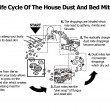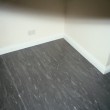B6.5 Insects: Dust mites
Dust mites and their excreta have been linked to asthma. Dust mites cannot be seen but they inhabit clothes, bedding, hair, carpets and soft furnishings. They require a high humidity environment to breed. They do not survive in ultraviolet light from the sun and they are unlikely to survive in a dry, well-ventilated environment.
There are many ways that humidity levels in houses can be increased:
- cooking areas generate steam
- shower and bath areas can generate large volumes of steam
- some space heaters that burn fuel (kerosene, paraffin) release water vapour into the air
- even residents breathing releases water vapour
- cold, uninsulated walls, ceilings and glass can cause any water vapour in the room to condense.
In all the above examples, increased population will increase the levels of use.
The prevalence of asthma can also be increased by environmental allergens such as pollen and industrial pollutants. It is important to discuss the incidence of asthma with the community and identify external factors that may also be contributing to asthma.
Australian data show that the majority of surveyed houses do not have fitted carpets (69%), a universally accepted breeding ground for dust mites. Only 42% of houses had roof insulation, an improvement of 5% since 2013. Lack of roof insulation can significantly increase temperature and humidity in the house because vapour condenses on uninsulated, cold ceiling surfaces.
Design and Specification
Ensure
- B6.5 .1.
wet areas and the kitchen have effective permanent ventilation to remove steam and reduce house humidity, without reducing security and privacy
- B6.5 .2.
the entire house has effective insulation and cross ventilation to reduce humidity
- B6.5 .3.
the house is sited to reduce the impact of environmental allergens; for example, orient the house to gain winter sun, which reduces humidity and decreases habitat for dust mites
- B6.5 .4.
residents are alerted to the fact that fitted carpets provide an ideal breeding area for dust mites and that other types of floor coverings might reduce the presence of dust mites
- B6.5 .5.
an external clothes line is available and accessible by a path, complying with AS 1428.1 Design for access and mobility.
Consider
- reducing humidity in the house by supplementing natural ventilation in the bathroom with exhaust fans that are ducted to an outside vent and fitted with a timer switch
- providing an externally vented exhaust fan in the kitchen
- insulating the walls, as well as the roofs, in high humidity areas such as the bathrooms, laundry and kitchen
- separating high humidity areas such as kitchens and bathrooms from living rooms and bedrooms
- in cold climates, using heating fuels that do not release water vapour - for example, kerosene and gas heaters tend to release water into the air
- using rugs or other floor coverings rather than fitted carpets (rugs can be aired in the sun, and hard floor surfaces do not provide as good a breeding environment for dust mites)
- in rooms that will be artificially heated or cooled, providing a means of venting air and admitting fresh air
- in tropical climates, fitting rain protection and security screens to all windows, so they can be left open, to assist in cross ventilation of the house (for information about fire escape requirements for screens, see A3.3 ‘Escape in the event of fire’).
Real world examples of Solutions
- B6.5 .1.
Quality control
- insulation has been correctly installed to the entire ceiling space, and it is the specified rating of insulation (called the 'R' value)

- COMPLETED DESIGN & SPECIFICATION
AT HANDOVER
FINAL COMPLETION
- COMPLETED DESIGN & SPECIFICATION
- if the roof space is vented check the vents are screened

- COMPLETED DESIGN & SPECIFICATION
DURING CONSTRUCTION
AT HANDOVER
FINAL COMPLETION
- COMPLETED DESIGN & SPECIFICATION
- walls are insulated and it is the correct specified rating of insulation

- COMPLETED DESIGN & SPECIFICATION
DURING CONSTRUCTION
- COMPLETED DESIGN & SPECIFICATION
- the bathroom can be naturally ventilated and when operating, any open window, vent or louvres do not compromise privacy

- COMPLETED DESIGN & SPECIFICATION
DURING CONSTRUCTION
- COMPLETED DESIGN & SPECIFICATION
- the kitchen area can be naturally ventilated and if fitted, exhaust fans are installed correctly and working.

- COMPLETED DESIGN & SPECIFICATION
DURING CONSTRUCTION
AT HANDOVER
FINAL COMPLETION
- COMPLETED DESIGN & SPECIFICATION
- if fitted, mechanical exhaust fans are working and ducted to the outside

- COMPLETED DESIGN & SPECIFICATION
DURING CONSTRUCTION
AT HANDOVER
FINAL COMPLETION
- COMPLETED DESIGN & SPECIFICATION
- the clothes line has been installed and is secure, and has an accessible footpath from the house.

- COMPLETED DESIGN & SPECIFICATION
AT HANDOVER
FINAL COMPLETION
- COMPLETED DESIGN & SPECIFICATION
- insulation has been correctly installed to the entire ceiling space, and it is the specified rating of insulation (called the 'R' value)
Maintenance
As part of cyclical maintenance, check:
- windows can be opened and closed

- Carpenter, Local Maintenance Team
- 12 Months
- any exhaust fans fitted to the house are working.

- Electrician
- 12 Months
- windows can be opened and closed
Standard And References
Asthma Foundation <http://www.asthma.org.au>
Sercombe, J, Liu-Brennan, D, Causer, S, Tovey, E. The vertical distribution of house dust mite allergen in carpet and the effect of dry vacuum cleaning. International journal of hygiene and environmental health. 2006; 0:0
Leeder, S, Habibullah, M, Mahmic, A, Jalaludin, B, Tovey, E. The effect of season on house dust mite allergen (Der P1) concentrations in reservoir and aeroallergen samples in Australia. Environmental Health. 2004; 4:35-44
Mihrshahi, S, Marks, G, Criss, S, Tovey, E, Vanlaar, C, Peat, J. Effectiveness of an intervention to reduce house dust mite allergen levels in children's beds. Allergy. 2003; 58:784-789
Asthma Foundation of Victoria 1994, Specification for an Asthma Friendly House.
Fifoot, A, Sieber, L & Tovey, E (eds) 1995, Mites Asthma and Domestic Design 2, University of Sydney, Sydney.


